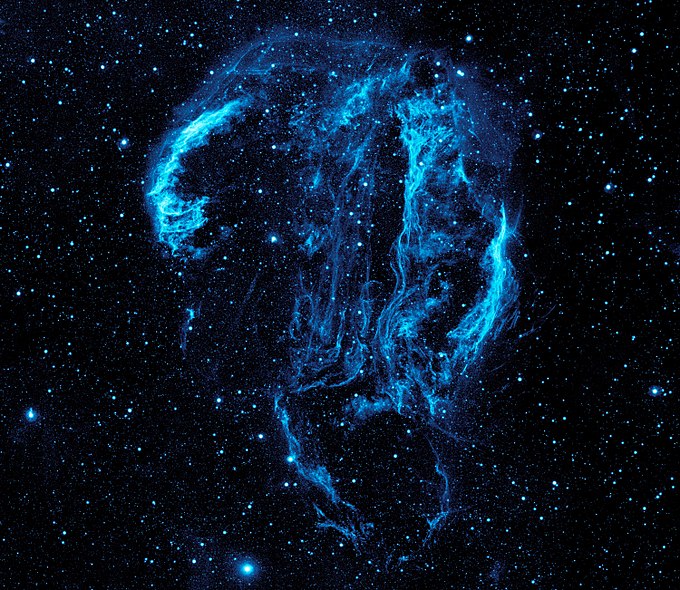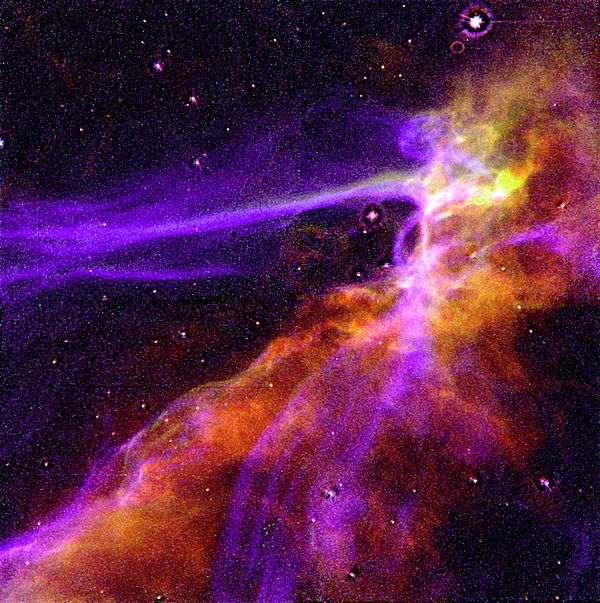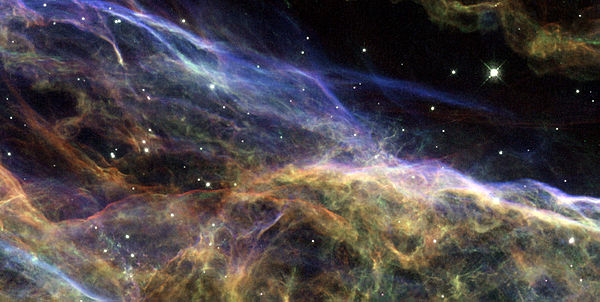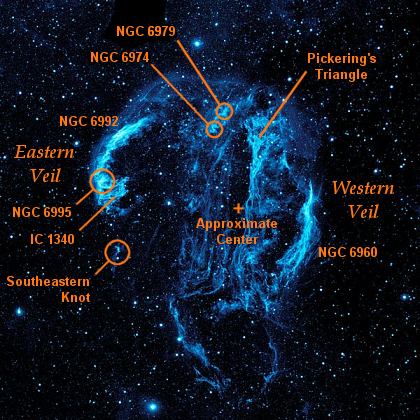An ultraviolet image of the Cygnus Loop

Photograph: NASA/JPL-Caltech
A large supernova remnant in the constellation Cygnus. Different parts of the loop emit electromagnetic radiation in different ranges, including visible light for the arcs known collectively as the Veil Nebula. The complete loop is only revealed through radio, infrared, and X-ray images.
The Cygnus Loop (radio source W78, or Sharpless 103) is a large supernova remnant (SNR) in the constellation Cygnus, an emission nebula measuring nearly 3° across.[1] Some arcs of the loop, known collectively as the Veil Nebula or Cirrus Nebula, emit in the visible electromagnetic range.[1] Radio, infrared, and X-ray images reveal the complete loop.
The visual portion of the Cygnus Loop is known as the Veil Nebula, also called the Cirrus Nebula or the Filamentary Nebula. Several components have separate names and identifiers,[2][3] including the "Western Veil" or "Witch's Broom", the "Eastern Veil", and Pickering's Triangle.
NGC 6960
NGC 6960, the Western Veil, is the western part of the remnant, also known as the "Witch's Broom", located at J2000 RA 20h 45m 58.1s Dec +30° 35′ 43″.[3] As the western-most NGC object in the nebula (first in right ascension), its number is sometimes used as an NGC identifier for the nebula as a whole.
NGC 6992, NGC 6995, and IC 1340
These three luminous areas make up the Eastern Veil. NGC 6992 is an HI shell located along the north-eastern edge of the loop at J2000 RA 20h 56m 19.0s Dec +31° 44′ 34″.[4] NGC 6995 is located farther south at J2000 RA 20h 57m 10.7s Dec +31° 14′ 07″,[5] and IC 1340 even farther south at J2000 RA 20h 56m 12.0s Dec +31° 04′ 00″.[6]
Pickering's Triangle
Also known as Pickering's Wedge, or Pickering's Triangular Wisp, this segment of relatively faint nebulosity was discovered photographically in 1904 by Williamina Fleming at Harvard Observatory, where Edward Charles Pickering was director at the time. The Triangle is brightest along the northern side of the loop, though photographs show the nebulosity extending into the central area as well.
NGC 6974 and NGC 6979
These two objects are generally identified today (as by the NGC/IC Project and Uranometria) with two brighter knots of nebulosity in a cloud at the northern edge of the loop, to the east of the northern edge of Pickering's Triangle. NGC 6979 was reported by William Herschel, and while the coordinates he recorded for Veil objects were somewhat imprecise,[7] his position for this one is tolerably close to the knot at J2000 RA 20h 50m 27.9s Dec +32° 01′ 33″.[7]
The identifier NGC 6979 is sometimes taken to refer to Pickering's Triangle,[8] but the Triangle is probably not what Herschel saw or what the Catalogue intended for this entry: it was discovered only photographically, after the Catalogue was published, and long after Herschel's observation.
NGC 6974 was reported by Lord Rosse, but the position he gave lies in an empty region inside the main loop. It was assumed that he recorded the position incorrectly, and the New General Catalogue gives Rosse's object as the other knot in the northern cloud, located at J2000 RA 20h 51m 04.3s Dec +31° 49′ 41″, one degree north of Rosse's position.[9] (This position is farther east than NGC 6979, even though NGC objects are generally ordered by increasing RA.) These filaments in the north-central area are sometimes known as the "carrot".[10] The spectrum at 34.5 MHz of the region associated with NGC 6974 ranges straight over the entire frequency range 25 to 5000 MHz



Hi, I found some acronyms/abbreviations in this post. This is how they expand: